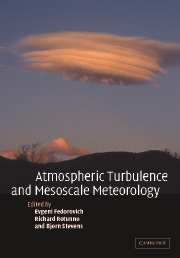Book contents
- Frontmatter
- Contents
- Preface
- Douglas K. Lilly: a biography
- Part I Atmospheric turbulence
- 1 Changing the face of small-scale meteorology
- 2 Phenomenological hunts in two-dimensional and stably stratified turbulence
- 3 Energy dissipation in large-eddy simulation: dependence on flow structure and effects of eigenvector alignments
- 4 Dreams of a stratocumulus sleeper
- 5 Large-eddy simulations of cloud-topped mixed layers
- Part II Mesoscale meteorology
- Appendix A Douglas K. Lilly: positions, awards, and students
- Appendix B List of publications by Douglas K. Lilly
- Index
- Plate section
4 - Dreams of a stratocumulus sleeper
Published online by Cambridge University Press: 04 August 2010
- Frontmatter
- Contents
- Preface
- Douglas K. Lilly: a biography
- Part I Atmospheric turbulence
- 1 Changing the face of small-scale meteorology
- 2 Phenomenological hunts in two-dimensional and stably stratified turbulence
- 3 Energy dissipation in large-eddy simulation: dependence on flow structure and effects of eigenvector alignments
- 4 Dreams of a stratocumulus sleeper
- 5 Large-eddy simulations of cloud-topped mixed layers
- Part II Mesoscale meteorology
- Appendix A Douglas K. Lilly: positions, awards, and students
- Appendix B List of publications by Douglas K. Lilly
- Index
- Plate section
Summary
Foggy recollections
When we were students at UCLA in the early 1970s, the California stratus deck frequently floated over our heads. There on the beautiful campus under the clouds, we studied Doug Lilly's (1968; hereafter L68) paper about cloud-topped mixed layers under strong inversions. The paper was recommended to us by our mentor, Professor Akio Arakawa, who recognized the relevance of Lilly's insights to climate dynamics. Whereas spectacular supercells leap from the boundary layer to the tropopause in a single bound, L68 analyzed “wimpy” stratus and stratocumulus clouds that are only a few hundred meters thick and barely manage to precipitate. L68 was a “sleeper.” It received little attention at first, but over the decades since then it has picked up many citations (417 as of June 2003), and it forms the groundwork for several currently thriving lines of research. L68's emergence as a classic research paper stems in part from the climatic importance of the cloud regimes it dealt with, but more importantly from the amazing prescience of Lilly's ideas and the clarity with which he expressed them.
Several ingredients, acquired over a number of years, came together in a two-week period during the summer of 1965 to produce the remarkable L68 paper. The first was personal experience and interest. Lilly's high-school physics teacher, at Sequoia Union High School in Redwood City, California, ran a weather club, which Lilly joined with enthusiasm. After becoming the club's student leader, Lilly began to evolve, by his own description, into a
weather junkie, keeping daily weather records, making forecasts, and testing their accuracy. When I learned to drive, I did something akin to tornado chasing, within the limits of California weather.[…]
- Type
- Chapter
- Information
- Atmospheric Turbulence and Mesoscale MeteorologyScientific Research Inspired by Doug Lilly, pp. 71 - 94Publisher: Cambridge University PressPrint publication year: 2004
- 7
- Cited by



